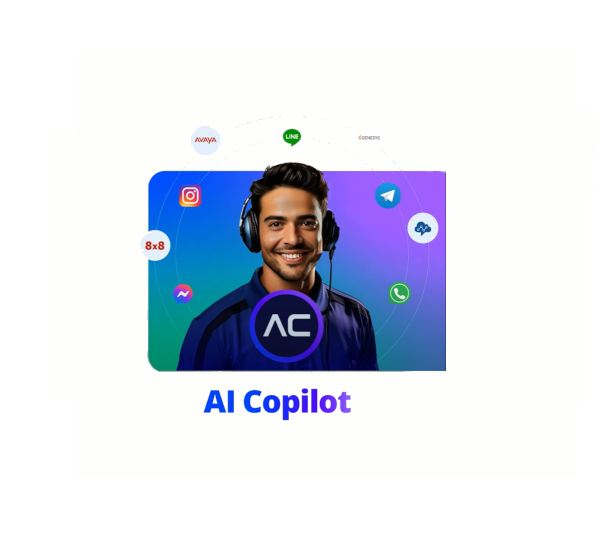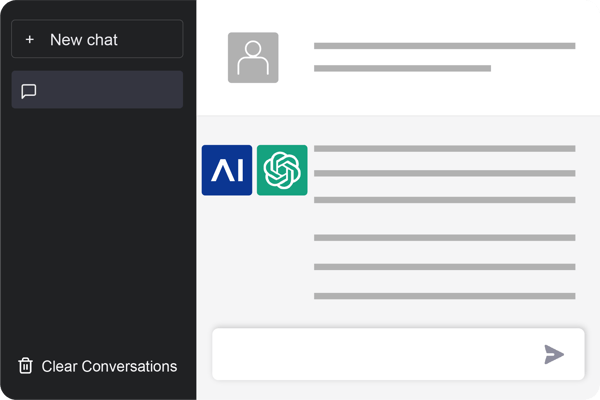Experts in the banking industry can all agree that adapting to digital innovations is crucial to the success of banks over the coming years. Self-service is one aspect of innovation where banks need to quickly replace outdated practices with new evolutions that meet shifting customer needs.
Nowhere is this idea more evident than in chatbots. Though still a relatively new concept, chatbots already face redundancy due to the rise of artificial intelligence (AI). The introduction of AI, specifically Conversational AI, and Generative AI, has revolutionized the capabilities of chatbot technology.
AI-powered banking chatbots can hold dynamic conversations with customers, identifying their needs and actioning their requests. By providing comprehensive self-service options and flexible customer support, AI chatbots revolutionize the very definition of ‘chatbot’ and provide new levels of efficiency, customer satisfaction, and operational savings.
In this guide, we’ll explore AI chatbots in the banking sector. We’ll demonstrate what they are, how they work, and what benefits they can bring to you and your team. If you want to remain ahead of your competition and provide cutting-edge self-service options to customers, read on to see how AI chatbots can help you succeed.
How Are AI Chatbots Changing the Banking Industry?
AI chatbots are set to transform customer service processes and reduce the need for physical branches. Customers can resolve customer service queries faster than ever, with no waiting times and 24/7 access across any device.
The dynamic nature of Conversational AI means AI-powered chatbots can be used to field virtually every type of customer interaction – with the potential to automate 90% of customer interactions in the banking sector.
As customers grow accustomed to better self-service options, banks will be forced to adapt and adopt better AI technology. In return, banks will benefit from greater levels of productivity and ultimately, stronger cost and labor efficiency. The McKinsey Global Institute (MGI) estimates that Generative AI alone could add between $200 and $340 billion or 2.8-4.7% of total industry revenues annually in the banking sector.
What Is a Banking AI Chatbot?
In their previous, more limited guise, chatbots were still useful to banks as a way to provide more self-service options to customers and help answer common queries. They were, however, too limited due to a reliance on predefined rules.
Pre-AI chatbots didn’t actually ‘understand’ a user’s input – they simply matched keywords to the appropriate response and served it to customers. This limited functionality meant chatbots were only ever a simple way to address generic problems.
The introduction of Conversational AI and Generative AI has drastically improved chatbot technology. Conversational AI gives a chatbot the ability to understand human language over voice or text, whilst Generative AI allows it to create content that answers queries or builds user knowledge.
An AI chatbot allows a user to interact with it via voice or text and mimics a human conversation. The chatbot creates personalized responses and carries out actions such as updating customer details and answering common questions.
The bot can recognize when a request requires human intervention and can then route the customer to the most appropriate service team – saving everyone time and preventing further frustration.
What Are the Pain Points of Banking AI Chatbots?
Though the utility offered by AI chatbots is compelling, banks need to weigh up some of the pain points before making a decision. The main considerations to bear in mind are as follows:
Hallucinations
Generative AI can sometimes present mistakes or errors as fact due to issues with the training data it uses. Banks and financial services businesses cannot afford to misrepresent information, so you simply cannot use any Generative AI models trained with public data, such as ChatGPT.
To minimize the risk of errors, you’ll need to work with a specialist AI provider like Cognigy to create an AI chatbot built with both Conversational AI and Generative AI. Conversational AI serves as the point of contact for a user and fields their queries, with Generative AI then carefully selecting and tailoring responses using precise prompt templates. This approach helps avoid hallucinations or other errors.
Don’t just take our word for it. Click here to see how 1 AI Agent handles 20 million calls a year without hallucinations or errors within a Fortune 100 insurance company – an industry just as risk-averse as banking.
Integrations & Existing Technology
Pre-defined parameters have highly limited chatbots of the near past. Conversational AI, on the other hand, leads to chatbots that can not only flex around customer intent but also actively accomplish tasks.
To be able to do this, the chatbot needs to integrate with your existing technology stack. This can pose issues for banking businesses – your stack may be highly complex, with both standard and bespoke tools and technologies managed by dedicated development teams.
To successfully deploy an AI chatbot into this environment, you must audit your tech stack, consult your development team, and ask your AI provider about integrations. Taking the time to do this pays off in the long term, as the more automation your chatbot can offer, the greater the productivity gains.
Benefits of banking AI chatbots
The benefits of chatbots in the banking industry are focused on improving your customer service processes to increase customer satisfaction. The introduction of AI into the chatbot landscape further increases the utility of chatbots and, therefore, the benefits they provide…
Improves Customer Service Offering
AI chatbots help decrease waiting times, speed up effective resolutions, and improve overall customer satisfaction.
AI chatbots aren’t tied to an office or working hours – meaning they can provide 24/7 access to customers. Users can interact with the chatbot when it suits them, using their preferred device, and get answers instantly rather than waiting for a human agent to pick up the phone.
Provides Personalization
Conversational AI can analyze customer data, read intent, and recognize patterns to produce personalized responses and suggestions. In the banking sector, this can be used to develop production recommendations or tailored financial advice – though both approaches will need strict planning from you and your AI provider to reduce risks.
Personalization doesn’t have to carry risks, of course. AI chatbots will also be able to take generic banking messages and terminology and make them more personal to each customer.
Traditional chatbots were always reactive – but AI chatbots can also take personalized, proactive actions to remind customers about upcoming bills, query security issues, or even request and process payments.
Expands Customer Access
As digital strategies mature, society is in danger of leaving certain audiences behind. For banks to cater to as many customers as possible, they need to offer multilingual support and give customers ways to bank that suit their needs.
AI chatbots play a key role in accomplishing this by providing multi-channel access in a way that feels intuitive. The chatbot is capable of understanding multiple languages and can reply in a way that mimics human conversation, allowing you to serve people speaking their native tongue without the massive costs of specialist translation teams.
Supports Omnichannel Needs
Chatbots using Conversational AI can integrate across digital channels such as mobile, web, and social media platforms like WhatsApp or Facebook Messenger. This means customers can choose their preferred method of contact and also minimizes the friction associated with a customer having to switch to a specific window or platform when carrying out a banking-related task like opening an account or changing personal details.
Improves Employee Satisfaction
AI chatbots aren’t only here to help customers – they have clear benefits for your existing employees. Far from replacing customer service teams, an AI chatbot is instead the ideal way to augment them. It can handle the majority of low-complexity, low-reward tasks so that your employees can focus on higher-tier cases.
Not only that, but the chatbot will also provide full context to the agent during handover and will remain involved during the interaction – transcribing information, analyzing intent, and retrieving answers or information that it will serve to your human agent.
Use Cases of Banking AI Chatbots
Let’s take a look at some use cases for banking chatbots to help demonstrate exactly where they fit into your existing processes and how they can help you improve customer satisfaction and overall business productivity.
KYC/ID&V
One of the most obvious and important use cases for chatbots comes in the form of identification and verification processes, often known as ‘know your customer.’ From extracting basic personal details to checking proof of identity, these tasks represent the biggest burden on your human workforce’s time and energy.
AI chatbots can not only automate the entire ID&V process but also present users with a document collection link if they need further verification and handle the entire conversation in the same window/device.
Questions & Answers
Customers often contact banks with easy-to-solve queries about their accounts or generic products. Rather than having to manually field these queries or invest in an FAQ resource buried in your website, an AI chatbot allows you to quickly and effectively answer questions. If the queries are about a user’s account, the bot can walk them through verification first. It can use Generative AI trained with your internal knowledge base to generate the answers if they're more generic.
Updating Personal Details
In a similar vein to ID&V, chatbots can be used to help customers accomplish basic tasks such as changing basic personal information on their accounts. This again removes the manual burden of a low-complexity task from your human agents and empowers customers to take action.
Considering how important it is for you to keep customer information up to date, providing a self-service chatbot option makes it straightforward for users, as it removes the barrier of having to pick up the phone.
Local Branch/ATM Services
Branches still play a vital role for some customers, who rely on them when faced with more complex or sensitive needs. An AI chatbot can be used to help direct users to local banking services, whether that be an ATM or a branch.
It could even be designed to augment the experience. For example: the chatbot could collect a user’s identification ahead of their branch visit and then once they arrive, direct them to the right teller who will have all of the prequalified customer information available to use.
Payment Processing
AI Chatbots can reactively and proactively handle payments with your customers. Whether they’re late on a specific charge and need reminding or you want to notify them ahead of time about a new fee, the chatbot can enter a conversation with a customer and let them know. It can also handle the payment itself, meaning the customer doesn’t have to navigate away and can take care of the issue in one interaction.
Loan Applications
Though banks have been offering online loan applications for several years, the process is usually unintuitive and lacks a way to engage customers. AI chatbots transform loan applications from a box-ticking exercise into a more flexible conversation where user can state their request and organically provide their information. The chatbot can carry out all of the initial steps and then contact a human agent to finalize the deal.
Examples of AI Chatbots in Banking
Use cases help show us potential implementations of chatbots in banking – but it’s also a good idea to study real-world examples of Conversational AI chatbots to see exactly how they help businesses in a similar industry…
A Virtual Assistant for 24/7 Support
Financial services provider Humm Group offers similar products and tackles many of the same customer service issues. As the provider grew, customer demand was weighing down their service team. After recognizing a need for a self-service solution, the business approached Cognigy.AI and Datacom to develop a 24/7 virtual agent named ‘Emm’.
Once deployed, Emm began providing around-the-clock support to answer customer requests. This resulted in reduced call handling times, better customer experiences, and a more satisfied human workforce. Get a better idea of the impact an AI chatbot can bring to your business in the full case study.
Best Practices for AI Chatbots in Banking
Before investing in an AI chatbot, you need to know the following best practices. Keeping these in mind when discussing potential solutions with AI providers will help you get the most out of your investment while minimizing risks…
Map Integrations
Chatbots must integrate with backend systems such as CRMs, fraud prevention, and payment processing technology. You’ll need to identify what interactions your AI chatbot will provide and then map the necessary integrations. Speak to your technical team and your AI provider to ensure all of the required access is achievable.
Start Small And Scale
Choose a narrow use case for your initial AI chatbot. Consider something that represents high demand but low complexity, such as ID&V. The chatbot’s impact will be more immediate and it will begin learning from customer interactions. Once it works effectively in one area, you can scale it to other processes and tasks.
Use Data to Grow
Big data has been invaluable in helping financial service businesses make important decisions. AI chatbots are an incredible source of business insight, as they gather transcripts for every interaction that can be stored and analyzed. In a short space of time, a bank can analyze everything from customer sentiment to common queries to make future-focused decisions.
Cognigy can Implement an AI Chatbot Solution for your Bank
Banks need to stay up to date with changing customer expectations. As more and more users shift to digital banking and move away from branches, AI chatbots will provide you with a reliable way to scale customer service interactions and improve customer experience.
Cognigy can help you develop bespoke AI Agents for your bank and customer base. Book a demo today to see how it works.
Frequently Asked Questions
What Is the Difference Between a Chatbot vs Conversational AI?
A chatbot traditionally refers to a single webchat bot that is limited to pre-programmed responses. Conversational AI is a type of AI that allows for natural language understanding and free-flowing conversations with users. Read our full chatbot vs Conversational AI guide to learn more.
How Does AI Chatbot Improve Customer Experience in Banking?
AI Chatbots improve customer experience by granting powerful self-service options with no waiting times. Customers can resolve queries and accomplish basic tasks without needing to speak to a human agent – though when a call does require human intervention, the AI chatbot’s role helps the agent speed up effective resolutions.
Can AI Replace Banking?
No, AI will not replace the banking industry or day-to-day banking needs. Instead, it will augment customer service interactions and help shape how customers use banking services going forward.

.png?width=60&height=60&name=AI%20Copilot%20logo%20(mega%20menu).png)




.png?width=600&height=600&name=Knowledge%20AI%20Feature%20image%20(2).png)













